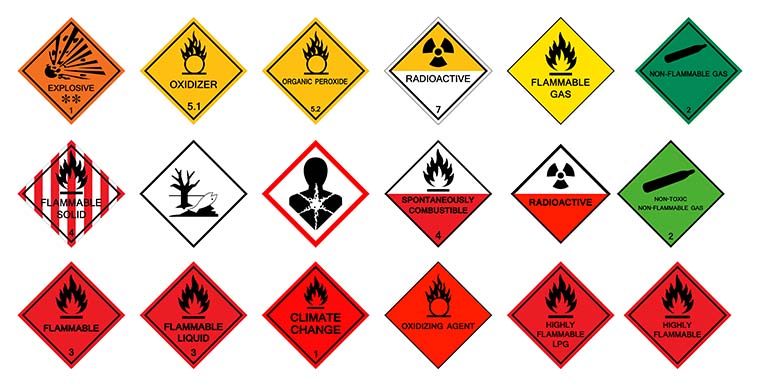What do you know about the ADR Code and the corresponding Agreement? If you are involved in the transport of dangerous goods, these are crucial concepts for you. We go deeper into the subject along the following lines: description, packaging and related regulations affecting carriers.
What is the ADR Code?
The ADR Code, which comes from the French“Accord Européen relatif au transport international des marchandises Dangereuses par Route” (European Agreement concerning the International Carriage ofDangerous Goods by Road), is a set of international regulations governing the inland transport of dangerous goods. This code establishes the conditions for packaging, labeling, documentation and safe transport of hazardous substances, with the aim of preventing accidents and protecting human health and the environment.
The ADR Code classifies dangerous goods into different typologies according to their nature and level of risk, from explosives and gases to corrosive substances and radioactive materials. Each class has specific packaging, labeling, documentation and handling requirements to ensure safe transportation.
Compliance with the ADR Code is crucial to prevent accidents, protect public health and the environment, and ensure efficient and safe transport of dangerous goods by road internationally.
What is the ADR Agreement?
The ADR Agreement mentioned above is an international treaty that establishes regulations for the safe transport of dangerous goods by road. To the ADR Agreement was signed by 32 countries and drawn up by the United Nations Economic Commission for Europe in Geneva in 1957, at which time most European states established common rules for the transport of dangerous goods by road on their territory and for border crossings. It was born with the main objective of protecting human life and the environment by establishing strict standards for the safe handling and transportation of hazardous substances.
How do the ADR Code and the ADR Agreement influence the transport of dangerous goods?
To comply with the ADR Code, logistics and transportation companies must be trained in the relevant regulations, have qualified and certified personnel, and ensure that vehicles and facilities meet established safety standards. In addition, it is critical that each shipment of dangerous goods be properly prepared, including proper packaging, transport documentation and appropriate marking on vehicles.
What characteristics must a qualified ADR Code professional meet?
Logistics professionals dedicated to the transport of dangerous goods must have the well-known card ADR To achieve this, they must take a course at an authorized academy and pass a specific exam on the transport of dangerous goods, types of dangerous goods, risks, handling, civil liability, and many other aspects.
At this point, it should be noted that the ADR license is not always mandatory when it comes to dangerous goods logistics, but there are these exceptions:
- Private or retail carriers of dangerous goods.
- Dangerous goods carriers in emergency situations.
- Carriers whose main activity is not the transport of dangerous goods.
What should an ADR container or packaging look like?
ADR regulations establish which goods are considered dangerous goods and the conditions under which they must be transported. This regulation includes the physical support in which the goods travel: tanks, containers or smaller containers/packaging (IBCs, drums, boxes, etc.). Let’s take a look at the most important aspects of ADR packaging of dangerous goods:
- Packaging instructions: Each hazardous substance is assigned an identifying UN number and is accompanied by specific packaging instructions. These establish the types of ADR containers and packages that may be used in each case, what materials they may be made of and what their maximum capacity is.
- Type and material of containers or packages: According to the ADR Code, there are 6 types of containers:
- 1 Drum
- 2 (Reserved)
- 3 Jerrican (or cuñete)
- 4 Box
- 5 Sack
- 6 Composite packaging
- 7 (Reserved)
- 0 Light metal containers.
And these are the 11 types of material from which these containers or packages can be made, according to the ADR Code:
- A Steel
- B Aluminum
- C Natural wood
- D Plywood
- F Wood chipboard
- G Cardboard
- H Plastic
- L Textile
- M Paper, multi-sheet
- N Metal (other than steel or aluminum)
- P Glass, porcelain or stoneware.
Thus, the result is an identification code obtained by joining the numbering associated with the genres with the letters assigned to each type of material. In addition, this identification code includes an alphanumeric combination representing the subcategory of each package. For example, the code 1A2 is used to designate “Steel drum with movable lid”.
Which substances are considered dangerous goods according to the ADR Code?
The list of dangerous goods according to the ADR Code is extensive. However, all of them are classified by their corresponding UN code, material and hazard identification numbers, as well as other nomenclatures that provide valuable information on the conditions under which the goods in question must be transported. Here are some examples:
| Subject identification number | Name of subject | Hazard identification number | Tags | Class, paragraph and letter of the enumeration |
| 1011 | Butane | 23 | 3 | 2, 2º F |
| 1017 | Chlorine | 268 | 6.1+8 | 2, 2ND CT |
| 1046 | Compressed helium | 20 | 2 | 2, 1º A |
| 1202 | Fuels for diesel engines | 30 | 3 | 3, 31º c) |
| 1203 | Gasoline | 33 | 3 | 3.3º b) |
Who ensures compliance with the regulations set forth in the ADR Code?
As the ADR Agreement was established between States, there is no authority in charge of enforcing it. In practice, the contracting parties are responsible for carrying out the appropriate roadside checks. However, there are European and national legal provisions that include rules in line with compliance with the ADR Code.
Do you have doubts about the application of the ADR Code in the transport of dangerous goods? Count on Partida Logística’s support!




